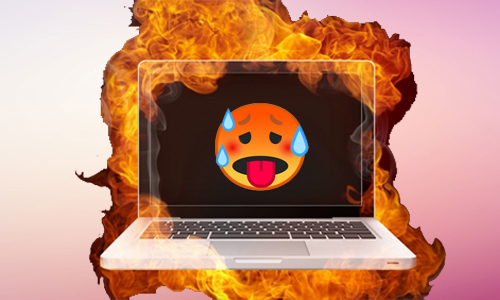How to fix MacBook overheating issue? As time passes and the MacBooks become older, they begin to malfunction. The most well-known of these is overheating. When the Mac gets hot, sitting on it becomes painful. So, what do you do if your MacBook overheats?
In this essay, I’ll discuss various ways to keep MacBooks from overheating. And if it does overheat, don’t panic; you can check at some hardware- and software-based solutions to solve your problems.
Table of Contents
What causes MacBook overheating?
Serval circumstances can overheat your MacBook. One of the main reasons is that your MacBook Pro’s fan is blocked. Another possibility is that you used a malfunctioning charger. Or you could make a stupid error and harm your MacBook.
Assume your equipment appears to be in good physical condition but is nevertheless overheating. In that situation, software issues such as excessive programme bulk, needless background processes, failure to shut down at regular intervals, and so on could be the culprits. The list goes on and on. Continue reading to learn more as I go over each of these difficulties one by one.
How to fix MacBook overheating issue?

Here is the list of 10 methods to fix the MacBook overheating issue:
Method #1. Use genuine Apple accessories
Low-quality accessories can cause your MacBooks to overheat. Aside from overheating, using low-quality accessories might shorten the life of your Mac.
Use only genuine MFi-certified accessories. It will boost the durability of your device and protect it from future damage. It will also ensure that your device remains under warranty.
Method #2. Unblock your Mac’s air vents to fix MacBook overheating issue
This is the most common blunder. I’ve occasionally accidentally obstructed my laptop’s vents, causing the MacBook Pro to overheat. (I mean, there’s a reason it blows hot air.)
Also, regularly clean the air vents with a little brush because dust particles tend to clog them. You have no idea how much harm dust can do!
Method #3. Unplug peripherals you don’t use
It’s critical to keep track of all the external devices connected to your MacBook. It occasionally demands additional power from the socket, which can cause your MacBook to overheat. As previously stated, only utilise MFA-certified products. It will not only keep your MacBook safe, but it will also increase its productivity.
Method #4. If the charging cable is damaged
Yes, you read that correctly. Damaged charging cables can cause your Mac to fail. When a charging brick or cable becomes broken or has an open wound, it invites difficulty. It may not startle you, but it will certainly heat up your Mac. If the charging cable becomes damaged, replace it right away to prevent further harm to the internal components.
Method #5. Check that Mac’s internal components are authentic
If you’ve had something changed or replaced inside your MacBook – a memory upgrade, a fan replacement, etc. – make sure the components you replaced or installed are authentic and not a knock-off.
To be honest, if you want to upgrade or replace certain internal components, I would recommend going to an Apple-authorised service centre. It would be great if you looking for these basic hardware fixes on your own, as they are simple to solve. Try any of these software remedies if your MacBook is still overheating.
Method #6. Update your MacBook to fix MacBook overheating issue
Apple provides seamless software upgrades, but it, like any other software, may have problems. Furthermore, such issues may cause your MacBook to run a little hotter. To avoid problems, update your macOS to the most recent software version. To update, go through the following steps:
- Click the Apple logo in the upper-left corner of your screen.
- Navigate to About This Mac.
- Select Software Update…
- If an update is available, click Update Now.
Method #7. Enable the graphics settings
Turning on the MacBook’s visual settings can help prevent overheating. It will assist you in synchronising your visuals with the CPU. To accomplish this:
- Click the Apple logo in the upper-left corner of your screen.
- Navigate to System Preferences.
- Proceed to Battery.
- On clicking, it takes you to Usage by default. Below Usage→click on Battery.
- Set Automatic graphics switching to on.
Method #8. Reset SMC on MacBook
An SMC reset is not required for any M1 Mac. All SMC functions are handled by the new, upgraded M1 chip, therefore these machines don’t even have a system management controller.
Check read our instructions on how to reset the SMC on your MacBook if it is Intel-based. Resetting the SMC can significantly reduce overheating problems.
Method #9. Reduce background processes to fix MacBook overheating issue
We sometimes get so caught up in our job that we forget to close the activities we’ve already started, and they continue to run in the background. This could be taxing on your MacBook. Take the following actions to end all unneeded background activities.
- Navigate to Finder.
- Tap the Applications folder to open it.
- Navigate to Utilities.
- Launch the Activity Monitor. Examine the activities; double-tap and Quit any that are not currently in use.
These open activities place additional strain on the processor and cause your MacBook to overheat. Check and close each one individually. They are also resource-hungry, consume a lot of RAM, and irritate your MacBook.
Method #10. Configure the energy-saving settings
There have been occasions when you have few duties but your fan is on full blast. This causes your Mac to overheat. What happens next?
You can remedy this by enabling the energy-saving mode on your MacBook. In this setting, your system will disable any background apps that aren’t absolutely necessary. To enable Low Power Mode, follow these steps:
- Click the Apple logo in the upper-left corner of your screen.
- Navigate to System Preferences.
- Proceed to Battery.
- By default, clicking brings you to Usage. Click on Battery under Usage.
- Enable Low Power Mode now.




